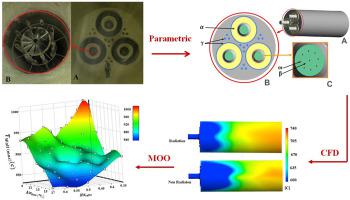Energy ( IF 9 ) Pub Date : 2021-01-15 , DOI: 10.1016/j.energy.2021.119859 Alireza Aminmahalati , Alireza Fazlali , Hamed Safikhani

|
In this study, the combustion chamber of a CO steam boiler is multi-objectively optimized (MOO) using computational fluid dynamics (CFD) and non-dominated sorted genetic algorithm II (NSGA II) algorithm. Multi-objective optimization with two input parameters and two objectives are followed. Input parameters are the two inlet air streams into the chamber called primary and secondary air streams. The optimization aims to maximize the outlet gas’s temperature and minimize the chamber’s wall’s temperature. Therefore, these two parameters are considered as the objectives of the optimization. To obtain an adequate number of nodes in the discretized system, a step-wise increase of the mesh is followed and finally, 6.1 million elements are selected. Due to the steam boiler complexity, some simplifications are assumed while it is assured that no remarkable error is introduced. Computations reveal that ignoring radiation at the beginning of the combustion chamber can cause an error as significant as 400 °C. In contrast, for the end of the combustion chamber, where optimization is performed over, an error up to 7.4 °C emerges. NSGA II algorithm is used for multi-objective optimization and the Pareto diagram is extracted and reported. Ultimately, the effect of different fluid intensity of primary and secondary air streams on different parameters like outlet temperature, gas composition in the outlet and the chamber’s wall temperature is presented.
中文翻译:

使用NSGA II算法对RFCC单元中的CO锅炉燃烧室进行多目标优化
在这项研究中,使用计算流体力学(CFD)和非支配排序遗传算法II(NSGA II)算法对CO蒸汽锅炉的燃烧室进行了多目标优化(MOO)。遵循具有两个输入参数和两个目标的多目标优化。输入参数是进入腔室的两个进气气流,分别称为一次气流和二次气流。优化的目的是使出口气体的温度最大化,并使腔室壁的温度最小化。因此,这两个参数被认为是优化的目标。为了在离散化系统中获得足够数量的节点,必须逐步增加网格,最后选择610万个元素。由于蒸汽锅炉的复杂性,在确保不会引入明显误差的前提下,我们进行了一些简化。计算表明,忽略燃烧室开始处的辐射会导致高达400°C的误差。相反,对于燃烧室的末端,在该末端进行了优化,出现了高达7.4°C的误差。使用NSGA II算法进行多目标优化,并提取并报告帕累托图。最终,提出了一次和二次空气流的不同流体强度对不同参数(例如出口温度,出口中的气体成分和腔室壁温)的影响。在进行优化的燃烧室末端,会出现高达7.4°C的误差。使用NSGA II算法进行多目标优化,并提取并报告帕累托图。最终,提出了一次和二次空气流的不同流体强度对不同参数(例如出口温度,出口中的气体成分和腔室壁温)的影响。在进行优化的燃烧室末端,会出现高达7.4°C的误差。使用NSGA II算法进行多目标优化,并提取并报告帕累托图。最终,提出了一次和二次空气流的不同流体强度对不同参数(例如出口温度,出口中的气体成分和腔室壁温)的影响。



























 京公网安备 11010802027423号
京公网安备 11010802027423号